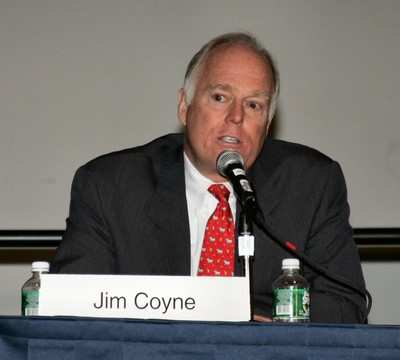Hearing On NTSB's "Most Wanted List" Of Safety
Improvements
 At a hearing before the US
House of Representatives Subcommittee on Aviation this week,
National Air Transportation Association President James K. Coyne
discussed efforts the group and its members have undertaken to
improve safety for both ground services and flight operations.
At a hearing before the US
House of Representatives Subcommittee on Aviation this week,
National Air Transportation Association President James K. Coyne
discussed efforts the group and its members have undertaken to
improve safety for both ground services and flight operations.
Testifying before a hearing regarding the National
Transportation Safety Board's "Most Wanted List" of aviation safety
improvements, Coyne expressed NATA's overall support for the NTSB's
recommendations, but cautioned against federal mandates requiring
aircraft operators to make expensive technology upgrades to
existing aircraft.
Six items on the "Most Wanted List" are directed to the Federal
Aviation Administration, with the NTSB classifying the FAA's action on
five of those recommendations as "unacceptable."
Coyne reiterated NATA's general support of the NTSB's
recommendations, noting that he has personally met with every NTSB
member to discuss aviation safety and what improvements could be
made to reduce accidents in the Part 135 community.
"Specifically, NATA supports the recommendations made by the
NTSB in regard to the dangers posed by known icing conditions, as
well as recommendations to increase requirements for cockpit voice
and data recorders and to extend the duration of time recorded by
this equipment," Coyne (shown below) said. "However, any FAA rules
requiring technological improvements should remain forward-fitting
and not apply to existing aircraft, as such upgrades will
disproportionately affect small general aviation aircraft."

In addition to the technology improvements to reduce runway
incursions recommended by the NTSB, Coyne also stressed the
importance of human factors training at all levels, noting that
NATA believes "the best approach to runway safety must include
human factors interventions to complement any technological
improvements."
In discussing the NTSB recommendations to reduce accidents
caused by human fatigue and implementing Crew Resource Management
training for Part 135 operators, Coyne spoke about NATA's
involvement with the Part 135 Aviation Rulemaking Committee, which
submitted a comprehensive proposal to the FAA in February 2005.
The ARC proposed altering existing flight, duty, and rest
regulations for Part 135 operators significantly as well as
requiring CRM training for 135 operators.
"NATA has participated in drafting comprehensive proposals
submitted to the FAA that would meet, and even exceed, the
recommendations made by the NTSB in these areas. We are hopeful
that in both cases, the FAA acts quickly on these recommendations
and initiates rulemaking to address these concerns," Coyne
said.
 As ANN reported, FAA Deputy
Associate Administrator for Aviation Safety Peggy Gilligan
responded to concerns voiced the day before by Mark Rosenker, NTSB
chairman, about the FAA's response to the Board's urgent safety
recommendations.
As ANN reported, FAA Deputy
Associate Administrator for Aviation Safety Peggy Gilligan
responded to concerns voiced the day before by Mark Rosenker, NTSB
chairman, about the FAA's response to the Board's urgent safety
recommendations.
"The relationship and interaction between the FAA and the NTSB
is an important component in aviation safety," Gilligan told the
Subcommittee. "Our roles are different, but complimentary. Through
accident investigation, the NTSB makes findings of probable cause
that lead to the issuance of safety recommendations. The FAA
receives the vast majority of the NTSB's safety recommendations. In
turn, the FAA takes action on the vast majority of the NTSB's
recommendations, even when the recommendation asks that we develop
new technology to address the recommendations."
In her response to a question regarding the implementation of
the Part 135 ARC recommendations at the hearing, Gilligan
classified the proposal submitted by the ARC regarding flight,
duty, and rest time as "interesting" and said the FAA would soon
initiate rulemaking on the proposal, but didn't give a specific
timeline.
Rosenker told the committee he was disappointed at the number of
recommendations to the FAA on the Board's Most Wanted List that are
in an unacceptable action status. He conceded items on the list
tend to be those that are among the most complex and difficult to
implement. However, he concluded, "while the FAA has made some
progress, I am disappointed that there are so many recommendations
on this list that are in an unacceptable status."
Coyne also discussed NATA's efforts to improve the industry's
safety record through the NATA Safety 1st Program. He noted
program's success in substantially reducing accidents among
aviation ground service providers since its inception in 1999. He
also introduced the organization's newest safety initiative, the
development of Safety Management Systems.
"The Safety Management System provides a complete safety
management program specific to a company's operation," Coyne said.
"The SMS is based on recognized safety standards and is supported
by rigorous industry data that will reduce or eliminate accidents
and their resultant costs, in terms of lives lost, injuries
sustained, insurance claims filed and direct financial losses
incurred.
"The NATA SMS can assist both air charter operators and
ground-based service providers in raising the safety and quality
bar that in turn will improve operational safety performance by
lowering incident rates and identifying potential risks for
accidents," Coyne added.
 ANN's Daily Aero-Linx (04.16.24)
ANN's Daily Aero-Linx (04.16.24) Aero-News: Quote of the Day (04.16.24)
Aero-News: Quote of the Day (04.16.24) Airborne 04.10.24: SnF24!, A50 Heritage Reveal, HeliCycle!, Montaer MC-01
Airborne 04.10.24: SnF24!, A50 Heritage Reveal, HeliCycle!, Montaer MC-01 Airborne 04.12.24: SnF24!, G100UL Is Here, Holy Micro, Plane Tags
Airborne 04.12.24: SnF24!, G100UL Is Here, Holy Micro, Plane Tags Airborne-Flight Training 04.17.24: Feds Need Controllers, Spirit Delay, Redbird
Airborne-Flight Training 04.17.24: Feds Need Controllers, Spirit Delay, Redbird





